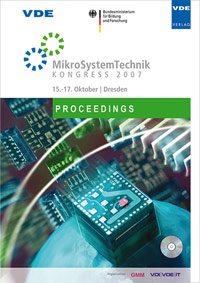CMOS Integrated Smart Cilia
Konferenz: MikroSystemTechnik - KONGRESS 2007
15.10.2007 - 17.10.2007 in Dresden, Germany
Tagungsband: MikroSystemTechnik
Seiten: 4Sprache: EnglischTyp: PDF
Persönliche VDE-Mitglieder erhalten auf diesen Artikel 10% Rabatt
Autoren:
Gieschke, P.; Held, J.; Doelle, M.; Bartholomeyczik, J.; Ruther, P.; Paul, O. (Microsystem Materials Laboratory, Department of Microsystems Engineering (IMTEK), University of Freiburg, Germany)
Inhalt:
This paper reports on a novel approach for the creation of smart cilia. The basic idea is the combination of a CMOS integrated stress sensor array with SU-8 posts fabricated on the chip surface. A bending of the posts results in a specific stress distribution which is detected by the stress sensors. Similar to biological tactile hair cell sensors, this device can detect small deflections of the tip of a post. The mixed-signal sensor chip contains an array of 1024 stress sensors occupying a total area of approximately 1 mm × 1 mm as well as circuitry for sensor addressing, signal amplification, A/D conversion, signal processing and a serial bus. The sensors are field effect transistors (FETs) with four source/drain contacts exploiting the shear piezoresistance effect in silicon. The usage of piezo-FETs in a new scalable matrix sensor selection concept enables the design of high-density stress sensor arrays of virtually any size with minimum wiring and pitches as small as 15 µm. The chip was fabricated using a 0.6 µm CMOS process of X-FAB (Erfurt, Germany). Single square SU-8 posts and an array of 64 circular posts were fabricated on individual chips. Controlled horizontal and vertical forces were applied to individual posts while recording the resulting stress maps. In case of vertical force, four symmetric sectors with positive and negative pseudo-Hall voltage are observed which is in excellent agreement with theoretical predictions. The position of a metal foil sweeping over the top of the posts is clearly indicated by the recorded stress map.


